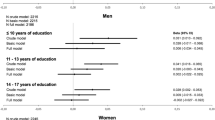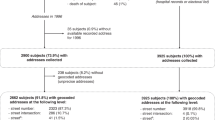Abstract
Objective: To investigate the independent association between three different measures of socioeconomic status and plasma ascorbic acid level.
Design: Cross-sectional population based study.
Setting and participants: 20 292 men and women aged 39–79 y who participated in the EPIC-Norfolk study.
Results: Individuals in manual social classes, who had no educational qualifications or those who lived in the most deprived areas had significantly lower levels of plasma ascorbic acid compared to those in nonmanual social classes, with at least O-level qualifications or who lived in less deprived areas. The magnitude of effect for each measure of socioeconomic status was greater in current smokers compared to current nonsmokers.
Conclusion: Education and social class were stronger predictors of differences in ascorbic acid levels, an indicator of dietary health behaviour, than a deprivation index based on the Townsend score. This suggests that education could be particularly important in influencing large socioeconomic differentials in health related behaviours and potentially, health outcomes in the UK.
This is a preview of subscription content, access via your institution
Access options
Subscribe to this journal
Receive 12 print issues and online access
$259.00 per year
only $21.58 per issue
Buy this article
- Purchase on Springer Link
- Instant access to full article PDF
Prices may be subject to local taxes which are calculated during checkout
Similar content being viewed by others
References
Bates CJ, Walmsley CM, Prentice A & Finch S (1998): Does vitamin C reduce blood pressure? Results of a large study of people aged 65 or older. J. Hypertens 16, 925–932.
Bennett S (1996): Socioeconomic inequalities in coronary heart disease and stroke mortality among Australian men, 1979–1993. Int. J. Epidemiol. 25, 266–275.
Block G & Sorenson A et al. (1987): Vitamin C intake and dietary sources by demographic characteristics. Nutr. Cancer 10, 53–65.
Chiplonkar SA, Agte VV, Mengale SS & Tarwadi KV (2002): Are lifestyle factors good predictors of retinol and vitamin C deficiency in apparently healthy adults? Eur. J. Clin. Nutr. 56, 96–104.
Day N, Oakes S, Luben R, Khaw KT, Bingham S, Welch A & Wareham N (1999): EPIC-Norfolk: study design and characteristics of the cohort. European Prospective Investigation of Cancer. Br. J. Cancer 80, 95–103.
Enstrom JE, Kanim LE & Klein MA (1992): Vitamin C intake and mortality among a sample of the United States population. Epidemiology 3, 194–202.
Gale CR, Martyn CN, Winter PD & Cooper C (1995): Vitamin C and risk of death from stroke and coronary heart disease in cohort of elderly people. BMJ 310, 1563–1566.
Khaw KT, Bingham S, Welch A, Luben R, Wareham N, Oakes S & Day N (2001): Relation between plasma ascorbic acid and mortality in men and women in EPIC-Norfolk prospective study: a prospective population study. European Prospective Investigation into Cancer and Nutrition. Lancet 357, 657–663.
Khaw KT & Woodhouse P (1995): Interrelation of vitamin C, infection, haemostatic factors, and cardiovascular disease. BMJ 310, 1559–1563.
Kurl S, Tuomainen TP, Laukkanen JA, Nyyssonen K, Lakka T, Sivenius J & Salonen JT (2002): Plasma vitamin C modifies the association between hypertension and risk of stroke. Stroke 33, 1568–1573.
Rosvall M, Ostergren PO, Hedblad B, Isacsson SO, Janzon L & Berglund G (2000): Occupational status, educational level, and the prevalence of carotid atherosclerosis in a general population sample of middle-aged Swedish men and women: results from the malmo diet and cancer study. Am. J. Epidemiol. 152, 334–346.
Shohaimi S, Welch A, Bingham S, Luben R, Day N, Wareham N & Khaw KT : Residential area deprivation predicts fruit vegetable consumption independently of individual educational level occupational social class: a cross-sectional population study in the Norfolk cohort of the European Investigation into Cancer (EPIC-Norfolk). J. Epidemiol. Community Health, in press.
Smith GD, Neaton JD, Wentworth D, Stamler R & Stamler J (1996): Socioeconomic differentials in mortality risk among men screened for the Multiple Risk Factor Intervention Trial: I. White men. Am. J. Public Health 86, 486–496.
Stallone DD, Brunner EJ, Bingham SA & Marmot MG (1997): Dietary assessment in Whitehall II: the influence of reporting bias on apparent socioeconomic variation in nutrient intakes. Eur. J. Clin. Nutr. 51, 815–825.
Townsend P, Phillimore P & Beattie A (1988): Health and Deprivation: Inequality and the North. London: Croom Helm.
Wardle J, Parmenter K & Waller J (2000): Nutrition knowledge and food intake. Appetite 34, 269–275.
Wang MQ (2001): Social environmental influences on adolescents' smoking progression. Am J. Health Behav. 25, 418–425.
Acknowledgements
We thank the participants and general practitioners who took part in the study and the staff of EPICNorrfolk. EPIC-Norfolk is supported by research programme grant funding from the Cancer Research Campaign and Medical Research Council with additional support from the Stroke Association, British Heart Foundation, Department of Health, Europe Against Cancer Programme Commission of the European Union, Food Standards Agency and Wellcome Trust.
Author information
Authors and Affiliations
Contributions
Competing interests: none.
Contributors: KTK, ND, SB and NW are principal investigators in the EPIC-Norfolk population study. AW and SB are responsible for the dietary measurements and analyses. RL is responsible for data management and computing and data linkages for post coding. SS conducted the data analyses and wrote the paper with KTK with contributions from other co-authors.
Corresponding author
Rights and permissions
About this article
Cite this article
Shohaimi, S., Bingham, S., Welch, A. et al. Occupational social class, educational level and area deprivation independently predict plasma ascorbic acid concentration: a cross-sectional population based study in the Norfolk cohort of the European Prospective Investigation into Cancer (EPIC-Norfolk). Eur J Clin Nutr 58, 1432–1435 (2004). https://doi.org/10.1038/sj.ejcn.1601979
Received:
Revised:
Accepted:
Published:
Issue Date:
DOI: https://doi.org/10.1038/sj.ejcn.1601979
Keywords
This article is cited by
-
Prevalence of COPD and its association with socioeconomic status in China: Findings from China Chronic Disease Risk Factor Surveillance 2007
BMC Public Health (2011)
-
The effect of social demographic factors, snack consumption and vending machine use on oral health of children living in London
British Dental Journal (2006)



